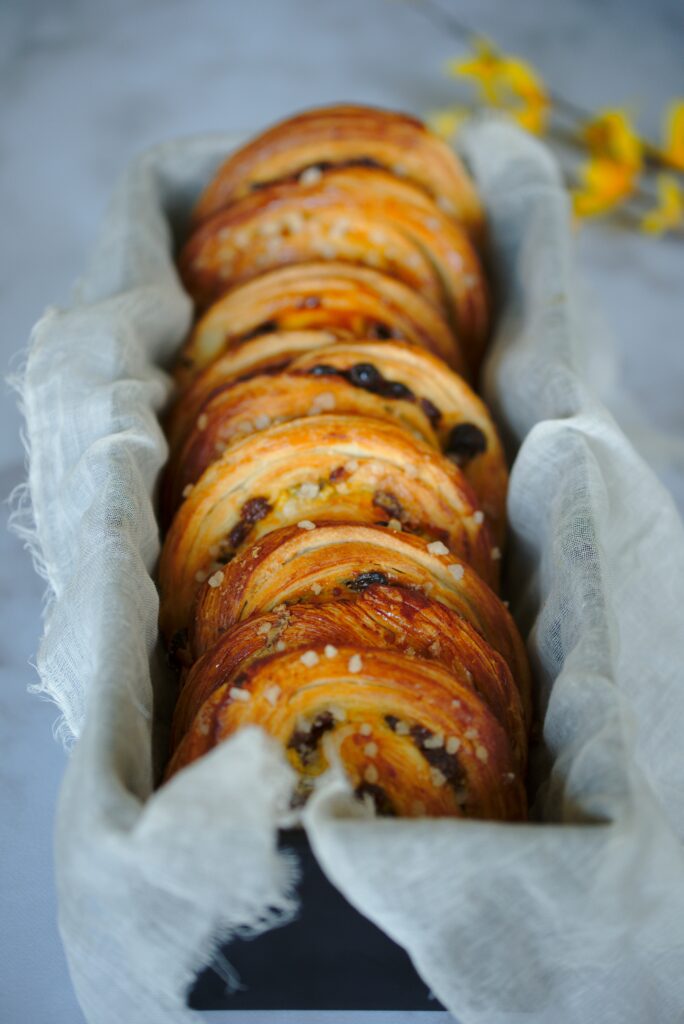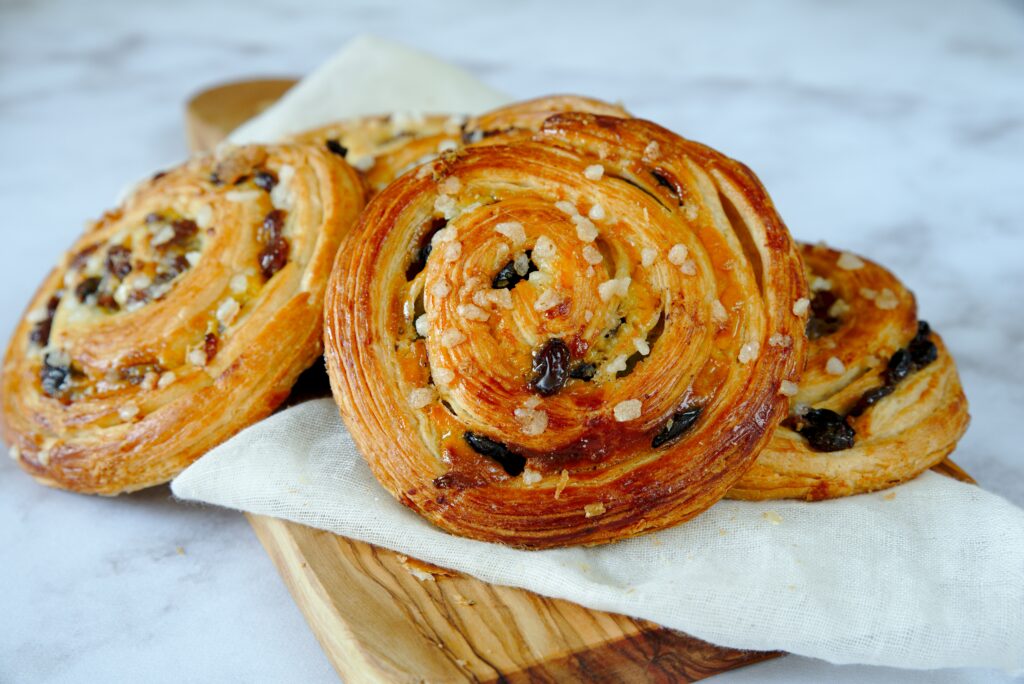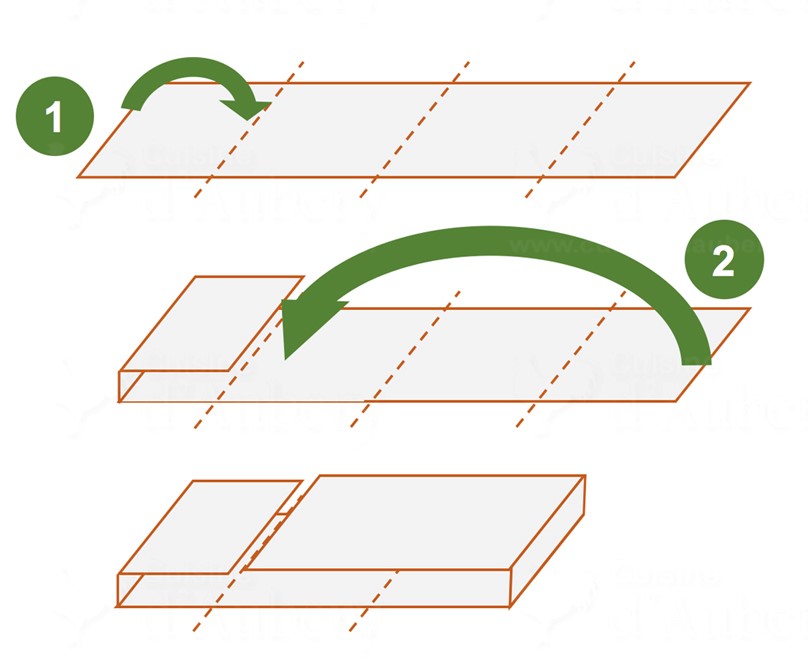One of the lesser known french pastries, pains aux raisins are to be honest one of my favorite viennoiseries. Also known as escargot, due to the form or brioche aux raisins in the south of France. Pains aux raisins consist of a thin sheet of pâte feuilletée levée, onto which a layer of pastry cream is spread, topped with raisins. Then it’s rolled up and cut into thin slices. Once baked, they’re a lovely, flaky dessert with a touch of pastry cream and nice plumb raisins.

It’s also a nice way to continue to practice PLF (pâte feuilletée levée). To be honest, it’s exhausting making endless croissants & pains aux chocolats. Even if you’re not a fan of raisins, you can switch up the fillings. For one of my first CAP blanc, I filled them with a pistachio pastry cream and chocolate chips. Mr. Hubby isn’t a fan of raisins, so I generally make half chocolate chip and the other half raisins for myself.
Détrempe
As the base of this recipe is the same as croissant dough, you’ll start off with what we call the détrempe. In a mixer bowl, you’ll add all of the liquids and yeast, then cover it entirely with the flour. The salt and sugar are added to opposite sides of the bowl with the softened butter in the middle.

Once the dough comes together, you’ll let it proof for half an hour at room temperature and an additional half hour (or longer) in the fridge.
Lamination
The lamination process is exactly the same as croissant dough. The détrempe should be rolled out to three times the length of the butter square. Place the butter in the middle, then fold the dough over the butter, enveloping it dough. With the rolling pin, press down on the open ends, to seal the the butter in.

Roll the dough out to about 50cm in length and brush off the excess flour. If you find it resisting and shrinking when you’re rolling it out, that means it’s not cold enough. Wrap it in plastic wrap and let it chill a bit longer. Then proceed with a single fold as pictured below.

Rotate the dough, so the ends are on the top and bottom and the seam is to your right. Roll the dough out to about 50cm in length and brush off the excess flour. Fold both ends into the middle until they meet, brush off excess flour again, then fold in half. This completes your first double fold.

Let the dough rest in the fridge for at least 30 minutes before proceeding with another simple fold and another double fold. In total, you should have 2 simple folds and 2 double folds. When you’re first familiarizing yourself with the process, I would suggest putting the dough in the fridge for around 15 minutes between each fold. This will keep the butter from getting too soft and melting into the dough while you’re working with it.
Can I freeze them?
This is a question that is asked quite often. You can freeze them prior to the last proof. However, in this case, you should add extra yeast to your dough. The general recipe calls for 20g of fresh yeast. If you plan to freeze them, I suggest using 50g. Why? When you freeze yeast, some of it dies, making it less efficiant when you do need to proof. In professional bakeries, they up the yeast amount to counter this effect.

I also freeze pains aux raisins, croissants or pains aux chocolats after they’ve been baked. To reheat them, simply put them in an oven at 170°c for about 5-8 minutes or until warm throughout. This brings back some of the crispiness that the puff pastry has, which you will loose instantly if you reheat in the microwave.

Pains aux Raisins
Ingredients
Pâte Feuilletée Levée
- 500 g flour, type 45
- 60 g granulated sugar
- 10 g salt
- 20 g fresh yeast
- 130 ml milk
- 120 ml water
- 50 g butter
- 250 g dry butter
Crème Pâtissière – Pastry Cream
- 250 ml milk
- 80 g egg yolk
- 50 g granulated sugar
- 20 g Poudre à Creme, or corn starch
- 10 g rum, optional
Raisins
- 100 g granulated sugar
- 100 ml water
- 150 g raisins
Finishings
- 1 egg yolk
- splash of milk
- big pinch of sugar
- pinch of salt
- 200 g pearl sugar
Instructions
Détrempe/Dough
- Dissolve the yeast in the liquid in the mixer bowl. Add flour, covering the liquid entirely.
- Add the sugar and salt to opposite sides of the bowl, with the butter in the middle and mix with the dough hook on slow.
- Once the dough starts to come together, bring the speed up to medium.
- Let mix for 10 minutes or until the dough becomes elastic.
- Roll into a ball and place into a bowl. Cover with plastic wrap, with the plastic wrap in contact with the dough. Let proof at room temperature for 30 minutes.
- Degas the dough, pull back into a ball. Cover with plastic wrap, in contact with the dough. Let proof in the fridge for a minimim of 30 minutes.
Pastry Cream
- In a sauce pan, add the milk, vanilla grains and half of the sugar. Bring to a boil.
- In a bowl, mix together the egg yolks and the other half of the sugar until lightened in color. Add the poudre à crème (or corn starch) and mix again.
- Once the milk is boiling, pour half of the milk on the eggs, whisking nonstop.
- Pour the egg mixture back into the sauce pan and cook on medium heat, whisking continuously.
- Once the pastry cream thickens (after about 4 minutes), pour it through a sieve and into the casserole, spreading it out into a thin layer. Cover in plastic wrap, making sure it is in contact with the cream and transfer to the freezer for 10 minutes.
- After 10 minutes in the freezer, transfer to the fridge and let it continue to cool.
Raisins
- In a sauce pan, heat up the sugar and water to create a simple syrup.
- Once the sugar has dissolved completely, take it off of the heat and add the raisins. Set aside and let them rehydrate.
Lamination
- After the dough has rested, prepare your dry butter.
- Place the butter on one side a sheet of parchment paper. Using a rolling pin, beat the butter until it is soften, folding it over on itself three or four times when it starts to get too thin and start again. Your goal is to have the butter to be the same consistency as the dough.
- Once the butter is the correct consistency, fold the parchment paper over the butter and fold in the sides, creating a closed square. Roll the butter into a flat sheet and be sure to roll into the corners.
- Put the butter in the fridge for 10 minutes.
- Take your dough out of the fridge and start to roll out into a long rectangle, large enough to fit the square of butter to fit in the middle and enough excess to on the top and bottom to fold over the butter.
- Once the butter is cold again (it should be the same temperature as the dough, this is when a laser thermometer comes in handy), turn out into the middle of the rectangle. Fold the sides of the dough, joining the ends together in the center, enveloping the butter in dough. Use the rolling pin to close the ends of the dough, sealing the dough inside.
- Flour the surface of the dough and ensure that there is enough flour underneath as well, so your dough will not stick. If it sticks, the dough will rip and your precious butter will leak out.
- With the rolling pin, press down slightly every couple centimeters to keep the butter from sliding around. Start rolling out the dough in length (the length of your rolling pin).
- Remove the excess flour with a pastry brush, divide into 3rds, folding the first 3rd, and then remaining end on top of the first fold. This is called a single fold. Seal the ends together lightly with your rolling pin.
- Wrap and let chill in the fridge for 30 minutes
- Dust the chilled dough with flour and press down every couple centimeters with your rolling pin, before rolling out in the opposite direction as you previously did.
- Lightly roll lengthwise. It should be slightly longer than your rolling pin. Try to keep the same thickness throughout.
- Do your first book fold (tour double). Fold both ends into the middle to meet, then fold in half. Cover and let rest in the fridge for 30 minutes
- Roll out into a rectangle that is about 30cm x 40cm. Trim all of the edges, so you have straight lines. Transfer to the fridge while you prepare for the next step.
Assembly
- Transfer the chilled pastry cream to a bowl and loosen it up with a whisk.
- Spread an even layer of pastry cream onto the chilled sheet of dough, leaving 1cm on one of the short sides.
- Drain the raisins and sprinkle them over the pastry cream.
- Wet the bare end of the dough with a bit of water, this will help seal the dough.
- Start rolling up the dough from the opposite end of the side that you wet with water. Press down slightly when you get to the other end to help seal the log.
- Wrap in plastic wrap and put in the fridge to set for about 10 minutes. This will help when you cut the slices later.
Finishings
- Mix the egg yolk with a bit of milk, sugar and salt for your egg wash. Set aside.
- Prepare your baking sheets with sheets of parchment paper.
- Remove the dough from the freezer and using a sharp knife, cut into 16 slices, approximately 1cm thick. Place each slice on the baking sheets, leaving ample enough room between each roll. They will almost double in size after baking.
- If the end of the roll comes undone, simple tuck it under the main part of the roll. Use a cake spatula, flatten out the top of each roll and nudge them back into circle form if necessary.
- Brush each roll with egg wash, tops and the sides.
- Put in a warm area and let proof for about 2 hours. You can also create a proofing chamber in your oven, which will help speed up the process. Preheat the oven to 40°C (105°F), then turn it off. Place a bowl of boiling water in the bottom of the oven and then put the baking sheets in the oven. In this case, watch the temperature. If you're not using dry butter, it should not exceed 28°C (82°F), or the butter will melt. If you're using dry butter, you can push it to 32°C (90°F)
Baking
- Once the rolls have proofed, preheat the oven to 180°C (350°F)
- Brush each of the rolls with egg wash once again. Sprinkle each one with pearl sugar.
- Bake for about 15 minutes, turning the pans half way through. Transfer directly to a cooling rack.
- You can brush each roll with a simple syrup as soon as it comes out of the oven if desired. I find it helps keep them from drying out too quickly. To make a simple syrup, it's equal parts of sugar and water.








Love it! I would love to try this out and may I know if I can use dry yeast instead of fresh one? If yes, how much will it be. Thank you for sharing and explained it in details.
Yes! You’ll just need to use the correct conversions. To convert from fresh yeast to active dry yeast, multiply the fresh quantity by 0.4, so you’ll need 8 grams of dry yeast, which is about 1tbsp. Be sure to active the yeast first. Take a bit of the liquid you’ll be using later (not all) and warm it up so you’re yeast activates. Then proceed on with the recipe as instructed! Let me know if you have more questions or need any help! Thank you so much for stopping by!
Thank you so much for your kind reply and explanation, Natalya. I look forward to trying this recipe as I have never made one.
These looks delicious!! Question about freezing then reheating the baked ones: should they be reheated wrapped in foil or unwrapped on a cookie sheet?
Thank you for stopping by! I throw them in a ziplock bag, then into the freezer. To head them up, I put them directly on a sheet pan and heat them up for about 5-10 minutes. This allows them to crisp back up without getting soggy. Hope this helps!
Hi! The recipe looks amazing! I plan on making them for my mother’s birthday. I want to serve them early in the morning but I don’t have time to prepare them the same day. Can I leave the raw dough overnight in the fridge for example? And if so after which step should I do this? Any tips and advise would be much much helpful! Thank you!!!
Hello Marta! You can definitely leave the dough overnight in the fridge, I would fill, roll and then wrap the ‘log’ in plastic wrap. You will still need to let them proof at room temperature prior to baking the next morning though!
Hi Natalya, thanks for sharing the recipe and detailed steps. I love pains aux raisins, it’s yummy! I tried to make this today but failed. My butter leak out when I roll the dough. I flour the counter and the dough but the moment I roll, butter leak out from all sides (although I sealed them) and my dough ripped. I redo, resulting the same again. Please advise so I could make these successfully again.
Hello Melody! The butter may be too warm, thus the leaking. Try to put it in the fridge for a bit to let it firm up a bit. Temperature wise, it should be about the same temperature as your dough. If you are rolling the dough and you see that it’s starting to leak, push down on each end with your rolling pin to reseal the dough and pop it in the fridge to chill a bit. I hope this helps!
Hi Natalya,I made your pains aux raisins a few days ago and they turned out amazingly – tasted just as I remember having in Brittany !
As the pains are best eaten when freshly cooked, would I be able to freeze the pains aux raisins, once portioned,then at a later date prove them,then bake ?
Hello Eleanor, I’m so glad to hear that they turned out! You can definitely freeze them before your first proof, just thaw them in the fridge prior to letting them proof, but can also freeze them after you’ve baked them and just pop them back in the oven to warm them again prior to serving. Happy baking!
Hi
Can you possibly give the dimensions of the butter and also the dough as I’m not sure how long the initial rectangle should be. Many thanks
Hell Andrea, the square of butter should be about 6inches x 6inches and the dough just big enough that you can fold both ends over to meet each other, covering the butter without overlapping the dough. But it doesn’t have to be down to the millimeter.
Hi! I want to try to make these for some house guests on Saturday morning. If I wanted to prep the dough the day/night before and then bake them in the morning, is that possible? At what point do I stop and refrigerate to then start up again the next day?
Hello Mimi, so sorry for the late response! I would either roll/cut then place on a baking sheet (as if you’re ready to bake) and keep them in the fridge, or wrap the roll in plastic wrap prior to cutting, store in fridge over night then slice and place on a pan. In both cases, you’ll need to proof them at room temperature or in an (off) oven with a container of hot water (for the steam) prior to baking.
Hi Natalya, Making Pain au Raisin had been on my to-do list for such a long time. Finally I found the time and courage to have a go. I followed your recipe yesterday and they turned out perfectly and tasted amazing – THANK-YOU! I popped the remainder in the freezer (to save for next weekend) but just had to get 2 out this morning as I was excited to see how they were after re-heating. I thawed at room temp for 15 mins then as per your recipe 170C for 5 mins – Perfectly yum, in fact possibly slightly better than yesterday as they were a little crispier. Me and my coffee are now complete.
Note: I wasn’t sure if it was necessary, but other recipes that i looked at involved more folding so I added point 13A – to repeat a second simple fold and a second double fold (resting in fridge in between).
I shall definitely make them again, although I now want to try Pain Au Chocolate too 🙂 Julie
Ah, lovely! So glad that you enjoyed them! Keep at it and happy baking!
I look forward to trying this recipe. I wanted to compliment you on the clearest and most straight forward graphics for the folds that I have ever seen on a recipe! Also, I have noticed a trend in recipes for viennoiserie that shortens the number of turns to two from the more typical three or four. I was wondering if you find this trend in France, or if it is more a USA thing, and what you think of it in practice. Thanks! KG
Thank you for your kind words! I’m glad I could be of some help! I have not actually seen this trend, I’ll definitely have to look into that!
I’m frensh living in the US and I found this recipe easy to follow and delicious. Merci beaucoup
Thank you for letting me know! Glad you enjoyed the recipe!
Can I use a different type of flour, I live in Austin Texas and I can’t find T45 flour anywhere, can I use cake flour?
Hello Marco, I would use All-purpose if baking in the states! Cake flour would be too light in gluten/proteins to work I’m afraid. Let me know how it goes!
How much vanilla do you use?
When using vanilla, I use half of a vanilla bean or I replace the 2 teaspoons of rum with vanilla extract.
These turned out perfect!